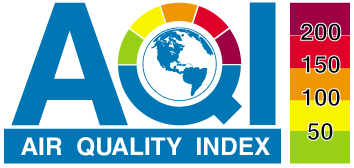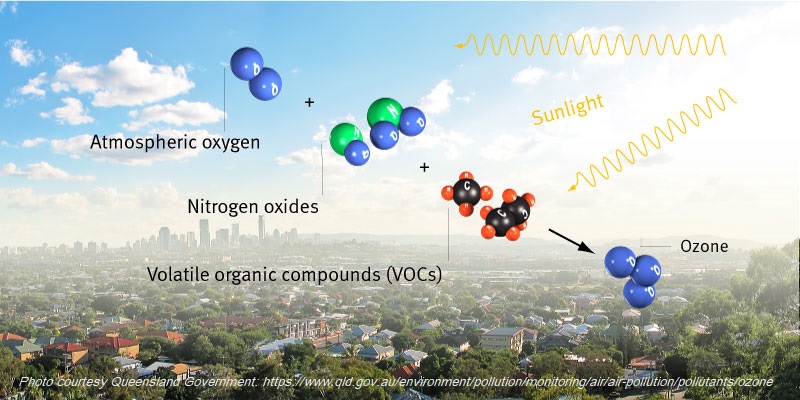May is Clean Air Month, and also includes World Asthma Day May 4. Why did May get chosen for Clean Air Month? In the Southeast, many states have ozone problems from May through September, so May is also the beginning of ozone season.
What Is Ozone?
Ozone is a molecule with 3 oxygen atoms. A regular oxygen molecule has 2 oxygen atoms. Ozone forms in the air, from a chemical reaction. Oxygen chemically reacts with nitrogen oxides and volatile organic compounds (VOCs), plus heat AND sunlight, to make ozone. Nitrogen oxides and VOCs mostly come from humans burning fossil fuels (vehicle exhaust, power plants, etc.). This makes ozone a human caused air pollution. Ozone forms each day, in the hottest part of the day, so it’s highest from 2-7pm.
Is Ozone A Problem?
There are two places in the atmosphere where we find ozone. Ozone in the stratosphere (about 10-20 miles above land) is actually good because it acts as a shield and protects us. Ground-level ozone, where we live and breathe, harms our health, and can even kill us.
What Are The Health Problems That Come From Ozone?
Ozone attacks and damages your airways and lungs, it causes irritation and inflammation. Ozone will make your eyes, nose, airways, and lungs sting or be sore. It can make you cough or have trouble breathing. It also makes you more susceptible to lung infections.
People who have lung diseases such as asthma, COPD, or emphysema have even more trouble with ozone. It can also cause asthma in children and teens who live in areas with high ozone. A recent study found that high long-term ozone levels is as bad for emphysema as smoking a pack a day of cigarettes.
Because ozone is such a threat to our health, on days with high ozone we have many more people admitted to hospitals, and more deaths.
Who Is Most At Risk from Ozone?
All children (including teens) are at risk from ozone, because their lungs are still growing. Children with asthma or other lung problems are especially vulnerable. Adults with lung conditions, such as asthma, COPD, or emphysema, and older adults (65 or older) are at risk. People who work or exercise outdoors are also at risk.
What Can We Do About Ozone?
There are 2 strategies for dealing with ozone: prevention, and avoidance.
Prevention means that we stop making nitrogen oxides and VOCs that contribute ozone forming. To do this, we need to stop burning fossil fuels and use clean transportation. Energy conservation, clean renewable energy, and clean transportation will really help us burn less fossil fuels.
The easiest thing to prevent ozone is energy conservation. Using less energy helps prevent air pollution instantly. Energy conservation includes: weatherizing homes, and using energy efficient appliances and machines. It can be simple things such as turning off lights, replacing light bulbs with LED bulbs, and turning off computers when we’re not using them.
Switching to clean renewable energy such as geothermal, solar, and wind power, will really reduce ozone. Power plants release both nitrogen oxides and VOCs. Drilling for oil and gas leaks a lot of methane into the air. Methane is one of the main VOCs that contribute to ozone forming. Also, we need all our transportation to be clean, electric vehicles: cars, buses, trucks, trains and as many bike and walk opportunities as possible. Construction and other off-road vehicles also need to be EVs. All of them, not just cars.
Avoidance means paying attention to Air Quality alerts for where you live, and not going out when ozone is high. 
You can find out the ozone level in the air where you live at the EPA AirNow website to see current air quality and air quality predictions. EPA and cities and states use the Air Quality Index (AQI) which is a measure of how much of all the kinds of air pollution are in the air at a given time. You can sign up for alerts at the EPA supported EnviroFlash service. If you have a smartphone, you can use the EPA AirNow app for Android or Apple phones.
The key thing to avoidance, is to remember that ozone peaks between 2-7pm. So if it’s an ozone alert day, get your exercise in the morning or at lunch, or after dinner.
How Can We Do It?
It takes both individual and government policy to reduce ozone.
If you are able, there are a lot of things you can do yourself: You can walk, bike or take transit. You can buy an EV car, or install solar panels on your house. You can change your lightbulbs, insulate and caulk, replace old windows with insulated windows, turn off lights and computers. You can replace older appliances with newer, more efficient appliances.
Some things will need government policies and support, at all levels of government: city, state, and federal. Policies can include incentives or grants for energy conservation, electric vehicles of all kinds, electric vehicle charging stations, and clean power. We need grants and subsidies for lower wealth and historically marginalized communities, to reduce energy burden and health disparities. EPA can set stronger air pollution standards. We can support solar, wind, and geothermal, and stop subsidizing fossil fuels.
And remember, because ozone comes from nitrogen oxides and VOCs which come from burning fossil fuels, anything we do to reduce ozone will also help fight climate change.
Do what you can as an individual, and use this link to advocate with your elected officials at all levels and let them know you want healthy air. It keeps us all healthier: Healthy Air is Health Care.
05/03/2021





